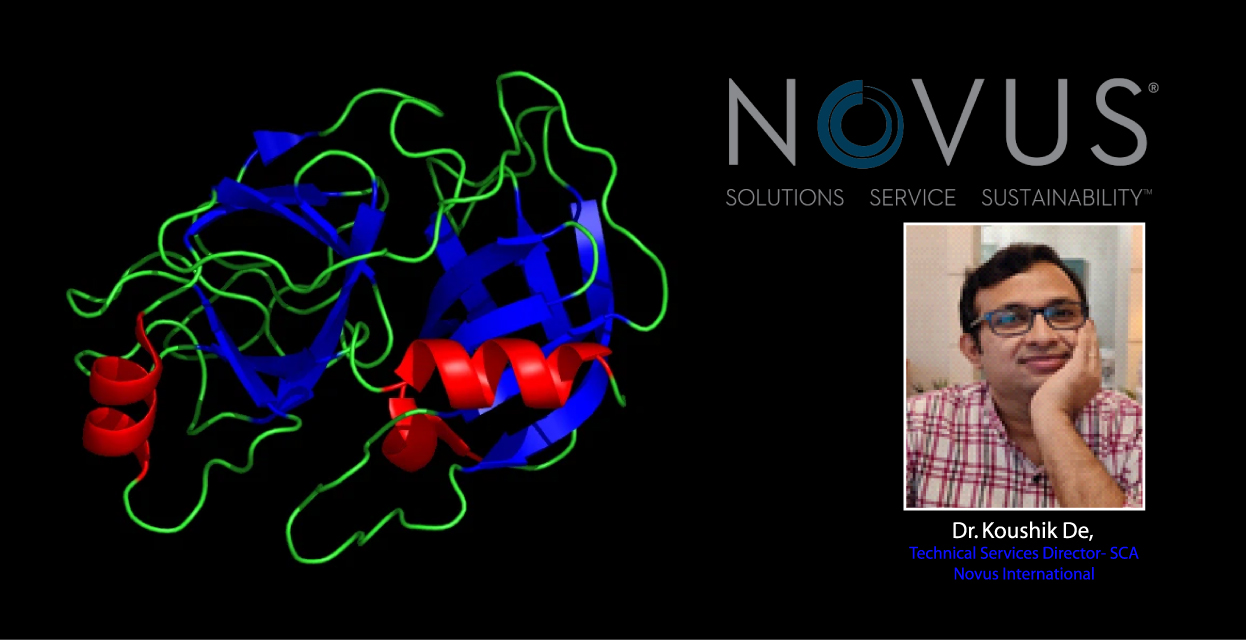 Dr. Koushik De: Enzymes increase nutrients available in feed ingredients. Since enzymes are substrate specific, the benefit of the enzyme in the diet is dependent on the mix of raw materials and the amount of substrate available.
Dr. Koushik De: Enzymes increase nutrients available in feed ingredients. Since enzymes are substrate specific, the benefit of the enzyme in the diet is dependent on the mix of raw materials and the amount of substrate available.
Assessment of added value of enzymes isn’t simple. The most accurate method is to use in vivo techniques with animals consuming semi-purified diets. Using this method, the direct effect of an enzyme can be understood for each raw material. As this method is expensive and not available to do it for everybody, the matrix approach based on nutrients contribution values given by the supplier has been widely adopted to evaluate an enzyme.
Using a set of nutrient matrix values for an enzyme is a practical approach and providing unique matrix values to a given enzyme ensures it can be applied simply to any kind of diet, regardless of the raw materials or the amount of substrate. This approach has been easy to adopt in practical formulations but has consistently demonstrated enzymes failing to meet expectations. These failures have been due to the lack of or an excess of substrate, and/or over-formulation.
When evaluating enzymes, a few concepts need to be made clear:
- Substrate: the specific substance on which an enzyme act
- Enzyme Effect: nutrients that a given enzyme will make available due to the direct enzymatic effect and the additional benefits accrued by the reduction of the substrate in the diet
- Avoid over-formulation: enzymes need “nutritional space” to express and thus diets need to be near the deficiency point to make a good estimation of the enzyme’s potential.
Trials for evaluating enzymes
The test of an enzyme requires being aggressive in the formulation and pushing the limits. Under-performing chickens will help provide a better evaluation of the enzymes and understand how accurate the formulation is.
Challenge Model: In this model, the diet with significant reduction of nutrients, that the enzyme will liberate and make available to the birds, needs to be formulated. Different enzymes can then be added on top.
Table 1: Challenge Model-Protease-10% reduction of the CP & AA from the specifications.
| T1 | T2 | T3 | T4 | T5 |
| Control | Neg Control | Protease A | Protease B | Protease C |
| Current Diet | Reduction of AA & CP by 10% | T2 + Protease A | T2 + Protease B | T2 + Protease C |
Objectives of the trial:
- “AA room” is created for enzymes to show their potential.
- Each supplier has different recommendations of how proteases affect the feed. This trial allows simplifying the comparison.
- Proteases can’t increase the AA digestibility 10% linearly. As a result, the AA ratio will be unbalanced and subsequently the performance of negative control as well as treatments will be lower than that of the control group.
- The most aggressive protease will have the best performance compared to T2.
- If any of the enzyme groups shows the same performance as the control group (T1), it signals some over formulation as no protease can increase 10% linearly on all the AA.
Response Model: The model is a variation of the ‘Challenge model’ discussed in the previous section. In this model, two control diets will be used; the current diet (this group is optional if there aren’t enough treatments) and a diet group with anywhere between 5% to 10% lower AA specifications. The control 2 specifications will be used for the treatment groups. There will be a reformulation following the matrix value recommendation of each protease supplier.
Table 2: Response Model – Diet reformulation
| T1 | T2 | T3 | T4 | T5 |
| Control | Control 2 | Protease A | Protease B | Protease C |
| Current Diet | Reduction of AA & CP by 5-10% | Reformulation of T2 + Protease A | Reformulation of T2 + Protease B | Reformulation of T2 + Protease C |
Objectives of the trial:
- Having T1 compared to T2 will assist in acknowledging any over-formulation or amino acid imbalance.
- Having lower specifications in AA and CP creates enough space for the enzyme to express to potential.
- This design allows each supplier to give their ideal recommendations.
- If the enzyme recommendation is too aggressive, the enzyme group will clearly show lower performance than T2 as long as there is a gap of performance between T1 and T2.
- If the enzyme recommendation is conservative and the enzyme can deliver additional benefits it will be reflected in greater performance than T2 as long as there is a gap of performance between T1 and T2.
Author: Technical Services Director- SCA, Novus International
 Agrinews24 কৃষির সাথে, কৃষকের পাশে
Agrinews24 কৃষির সাথে, কৃষকের পাশে





















